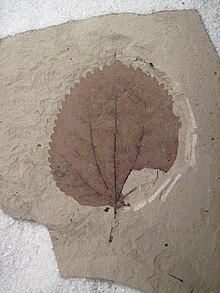Tetracentron hopkinsii
| Tetracentron hopkinsii Temporal range:
| |
|---|---|

| |
| Fossil leaf, Klondike Mountain Formation | |
| Scientific classification | |
| Kingdom: | Plantae |
| Clade: | Tracheophytes |
| Clade: | Angiosperms |
| Clade: | Eudicots |
| Order: | Trochodendrales |
| Family: | Trochodendraceae |
| Genus: | Tetracentron |
| Species: | †T. hopkinsii
|
| Binomial name | |
| †Tetracentron hopkinsii Pigg et al, 2007
| |
Tetracentron hopkinsii is an
Distribution and paleoenvironment
Tetracentron hopkinsii was initially described from two leaves, both recovered from the Early Eocene,
The Allenby Formation preserves an upland temperate flora which was first interpreted as being distinctly
Pigg et al noted in 2007 that one leaf assignable to Tetracentron had been found in the Klondike Mountain Formation of Republic, Washington, but was not complete enough to confidently attribute it to T. hopkinsii. The recovery of additional leaves deposited in the Stonerose Interpretive Center allowed Manchester et al to assign the Republic flora specimens to T. hopkinsii in 2018, expanding the confirmed distribution of the species.[3]
Taxonomy
Examination of the species was performed by Kathleen Pigg, Richard Dillhoff, Melanie DeVore and
Along with the 2008 description of Tetracentron atlanticum from the Mid to Late Miocene of Iceland, Grímsson et al documented and figured Tetracentron pollen recovered from the Princeton Chert locality of the Allenby Formation.[6]
T. hopkinsii is one of between three and four trochodendraceous species that have been described from the Klondike Mountain Formation. Broadly circumscribed, three other species have been identified in the Republic flora,
Description
The elliptical Tetracentron hopkinsii type specimen leaves have a length to width ratio of 1.3:1, being up to 9.5 cm (3.7 in) in length and up to 7.5 cm (3.0 in). The venation is
References
- ^ doi:10.1139/E04-095.
- ^ S2CID 86524324.
- ^ S2CID 92201595.
- .
- ^ Wolfe, J.A.; Tanai, T. (1987). "Systematics, Phylogeny, and Distribution of Acer (maples) in the Cenozoic of Western North America". Journal of the Faculty of Science, Hokkaido University. Series 4, Geology and Mineralogy. 22 (1): 1–246.
- ^ Grímsson, F.; Denk, T.; Zetter, R. (2008), "Pollen, fruits, and leaves of Tetracentron (Trochodendraceae) from the Cainozoic of Iceland and western North America and their palaeobiogeographic implications", Grana, 73 (2)
